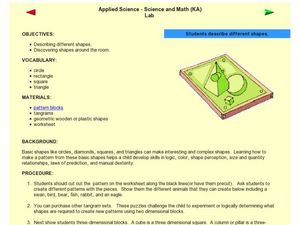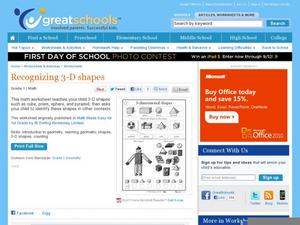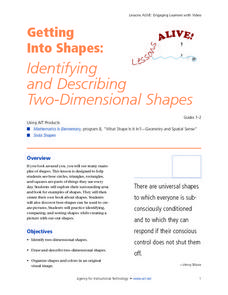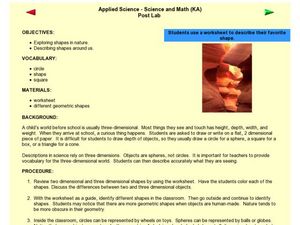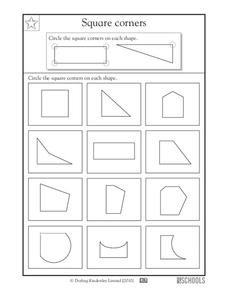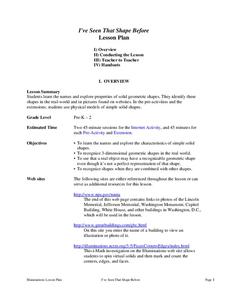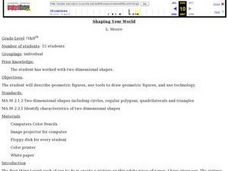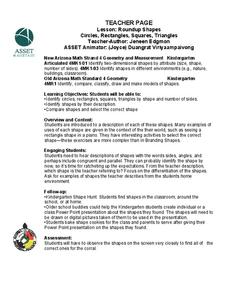Curated OER
2D Shapes
This engaging presentation would be helpful for your young learners of geometry. Pupils are given clues as to what a shape may be, then they have to use those clues to guess what shape is being described. Shapes used are the circle,...
Curated OER
Recognizing 3D Shapes, Part 3
Do your first graders know the difference between cones and cylinders? Use this handy activity to help youngsters learn geometric shapes. With prisms, spheres, and pyramids, among others, this resource prompts pupils to identify each...
Pennsylvania Department of Education
Shapes Around Us
Learners use manipulatives to study shapes. They sort shapes and use correct geometric terminology to describe them. Students find real-life examples of 2 and 3 dimensional shapes, and classify figures in their classroom according to...
Curated OER
Applied Science - Science and Math (K) Lab
In this shape instructional activity, learners cut out tangram shapes and create different pictures with them. They look at 3-D shapes as well. There is a nice, hands-on component built into this instructional activity.
Curated OER
3-Dimensional Shapes
Where is the vertex? Each of these three-dimensional figures is drawn so learners can see all sides and corners. They examine an example before trying six on their own. Some of these will be tricky, so be sure kids have covered this...
Curated OER
Sorting 3-Dimensional Shapes
Does it have corners? Scholars sort three-dimensional figures into one of two categories based on whether or not they have corners. They look at six shapes: sphere, cylinder, cone, cube, prism, and pyramid. For each,...
Curated OER
Making Two-Dimensional Shapes
Find the shapes that fit. Pupils explore visual discrimination in a set of geometry worksheets, which has them examine shapes that have been divided in half. They observe a set of shapes to determine which of them would fit into each...
Curated OER
Making Two-Dimensional Shapes
Which shapes fit? Learners practice visual discrimination using a geometry worksheet, which has them examine shapes that have been divided in half. They observe a set of shapes to determine which of them would fit into each half of the...
Curated OER
Name the 3 Dimensional Shapes of the Objects
Here are six solid figures for learners to identify. The names are listed along the left side and the shapes pictured on the right. Each shape is shown as a familiar object instead of just a drawing. Figures include a cylinder,...
Centre for Innovation in Mamatics Teaching
Area, Perimeter and Volume
Develop young mathematicians' knowledge of two- and three-dimensional shapes with this geometry workbook. From learning about the classifications of different shapes and figures to calculating their area, perimeter, and volume, this...
Curated OER
Getting Into Shapes: Identifying and Describing Two-Dimensional Shapes
Young scholars examine their classroom to find examples of various types of shapes. After identifying and describing the various shapes, they draw as many as they can on a piece of paper. They organize them into an image based on their...
Curated OER
Making Two-Dimensional Shapes
Use this introductory geometry worksheet as a projected warm-up for your class, doing it together and then revealing the explanation on the bottom half. Learners examine a square and a circle, each bisected by a dotted line. They must...
Curated OER
Applied Science: Exploring Shapes in Nature
Explore geometry with your young mathematicians! First, have them color in different two-dimensional and three-dimensional shapes. Then take them on a walk around the classroom. Can they identify different shapes using the target...
Curated OER
Square Corners
Which ones are square corners? As they learn more about shape attributes, be sure scholars understand the difference between a vertex and a square corner. After examining two examples, learners circle the 90-degree corners in 12...
North Carolina State University
Shapes
Expose youngsters to 3-D objects in a hands-on learning activity involving marshmallows and toothpicks. Engage your young mathematicians by introducing them to 3-D shapes by means of a story book. Explore 3-D shapes by manipulating...
Curated OER
Great Shapes Alive!
Compare two- and three-dimensional shapes and construct three dimensional models from two-dimensional shapes. Diagram the shapes and reflect about the process in writing.
Curated OER
Shapes
Fifth graders explore shapes. They recognize and name two-dimensional and three-dimensional shapes. Pupils discuss the properties and criteria for each shape they find in real life and construct a Kid Pix project using pictures of the...
Curated OER
Shapes Around Us
Pupils identify basic two-dimensional shapes. They are able to identify the four basic two-dimensional shapes: squares, rectangles, triangles, and circles. Students write/draw in their learning logs a reflection of what they noticed...
Curated OER
What's in the Bag?
Help your students identify the attributes of two-dimensional shapes. They read the book Round is a Mooncake, and use pattern blocks to sort shapes. Students sort shapes according to their attributes.
Fayetteville Public Schools
I've Seen That Shape Before
The objectives in the resource allow young scholars to explore the characteristics of simple solid shapes. Youngsters learn to recognize the face shapes, corners, and edges that make up 3-D figures by filling in a chart....
Curated OER
Shapes Galore!
First graders create two-dimensional shapes. In this shapes lesson, 1st graders learn about different two-dimensional shapes. Students have many hands-on experiences with these shapes including the use of geoboards, shaving cream, yarn,...
Curated OER
Shaping Your World
Learners describe geometric figures. They create pictures and list each shape they used to create their pictures. They discuss the importance of shapes in their lives and create ten different geometric shapes using the Drawing tools in...
Curated OER
Roundup Shapes
Shapes are all around us! Kindergartenrs identify shapes in their world and guess the shape being described. They participate in a shape hunt.
Curated OER
Understand Categories of Shapes
This colorful set of shapes and figures is the data set learners need to fill out an extensive table. For each of 11 types of shapes or figures they record the quantity and how many corners and sides each has. This becomes more difficult...



